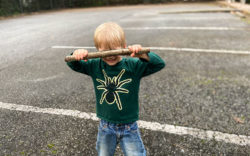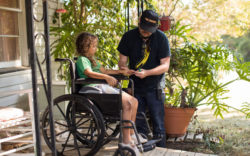I’ll admit, when I first learned my child would be wearing a uniform to school, I bristled.
In Clarke County, all middle schools require some form of a “uniform”—typically khaki or blue bottoms and a white or blue collared top. “But what about creativity?” I asked, pounding my fists into the table. “What about self-expression and identity? What if my child grows up only wanting to wear khaki pants and white polo shirts?”
For my child’s elementary years, she attended a school with no uniform policy. Not all elementary schools in the county have one. So, in my earnestness to foster her creativity at age 4, I embraced her clothing choices. Want to wear plaid with those leopard print leggings? Sure! Layering a puffy skirt with jeans and a leotard top? Why not?
At some point, her favorite outfit was a silky, quasi-see-through button-up shirt with cats playing on a white background, a cheetah-print tank top underneath and a different style of cheetah-print skinny jeans. On other days, she might break out the same pants with a rainbow tie-dyed shirt.
Around the same time, I read about Style Rookie, a blog started by the child fashion maven Tavi Gevinson. By age 11, her blog—mainly photos and her thoughts on the latest trends—had nearly 30,000 readers a day. Now, don’t get me wrong, my daughter’s favorite outfit was a statement, but not because of the cut of the pants or the silhouette of the shirt. For her, it had everything to do with how the clothes felt, not looked.
If we’re being perfectly honest, the morning ritual of picking out clothes always came with a certain amount of stress, as did shopping for school clothes every August. At the end of the day, how much did her choice of outfit reflect who she was? And if she had a selection of khaki pants and skirts to wear instead of leopard-printed ones, would it change that?
Sometimes we as adults impose our preconceived notions onto our children before they even have a hint as to how we feel. (Kind of like playing with Barbies—we as grown-ups think we’re instilling body image stereotypes into preschoolers; preschoolers just want to brush a doll’s hair and make her wear pants.) I’m sure there are kids who feel their clothing is an extension of who they are, and there are even court cases that challenge the ability of schools to limit children’s freedom of expression through their clothes. There’s some data that found school discipline incidents rose about 12 percent after the introduction of school uniforms, through discriminatory and racist overtones in how the rules are applied. Other accounts point to how girls, specifically girls of color, are unfairly targeted—often in relation to dress codes, though, not necessarily uniforms.
On the flip side, uniforms can be just that—unifying. For a school district such as Clarke County’s with a high rate of poverty among its students, uniforms can not only be less expensive than other clothes, but they also help level the playing field when it comes to style at school. Some studies even cite a feeling of “school pride” among students who wear uniforms—and that can elevate the overall school climate. They also create less drama when getting dressed in the morning, according to one national survey (which would be a bonus in my house).
Like the Barbie debate, I took a step back and thought about how much of my own ideas are forming my opinion, when it’s really not my opinion to have—it’s my child’s. And, I realized, if I could go back and do middle school all over again, would it have been better if I had to wear a uniform like everyone else? The memories that flashed through my head—of MC Hammer pants and stirrup pants and those shirts that changed color depending on your body heat—said a resounding yes.
Then I asked my daughter. We were hovering over a web page that had it all laid out—here are your shirts, here are your pants, here is a dress or two—and I wondered out loud: “What do you and your friends think of wearing uniforms?” She shrugged her shoulders. “Nah. It’s OK,” she said. And then, within five minutes, we completed our school shopping.
And the creativity part? Well, you probably had no idea how much fun you can have with socks, headbands, jewelry and reversible-sequin notebook organizers. I guess it just goes back to one of my favorite phrases: Know the rules, and then know how to break them.
Like what you just read? Support Flagpole by making a donation today. Every dollar you give helps fund our ongoing mission to provide Athens with quality, independent journalism.









